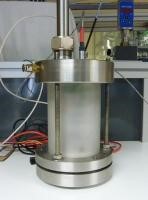Sludge treatment

Because wastewater is increasingly treated, large quantities of sludge (the residue of water purification) are produced each year and must be eliminated and/or recycled. Whatever the solution chosen (elimination or recycling), it is generally necessary, in a first step, to reduce the volumes of sludge produced by partially removing the water they contain. The activities of the laboratory regarding the treatment of sewage sludge come within this scope. From 2009 to 2013, research focused mainly on dehydration and to a lesser extent on incineration, the main aim being to obtain more efficient processes while trying to limit the energy cost and environmental impact.
It is a known fact that sewage sludge dehydration is a challenging process. Laboratory studies therefore examined the problem looking at two different, but nonetheless related, aspects: to better understand and characterize the reasons why sludge is so difficult to dehydrate and to study and develop new processes to improve dehydration of these materials.
Regarding the first aspect, a study was carried out to evaluate the impact of some of the physico-chemical parameters of the sludge (surface charge, hydrophobicity, exopolymer[e1] content and composition, percentage of fine particles, etc.) on the efficiency of the dehydration process. The second aspect was tackled essentially from the point of view of osmotic dehydration, in which a continuous electric field is combined with a mechanical (conventional) pressing action. Owing to this work, it has been possible to scale up from laboratory experiments to an industrial pilot.
Work concerning the osmotic dewatering of urban sewage sludge is under way. The characterization aspect was also addressed by studying the possibility of dehydrating a flocculated sludge by gravitational drainage and by putting forward a tool such as a gravity drainage index that could be used on an industrial scale.